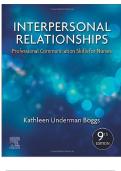Med C
,Table of contents
PART I: Conceptual Foundations of Interpersonal Relationships and Professional
CommunicationSkills
1. Theory-Based Perspectives and Contemporary Dynamics
2. Professional Guides for Nursing Communication
3. Clinical Judgment and Ethical Decision Making
4. Clarity and Safety in Communication
PART II: Essential Communication Skills
5. Developing Therapeutic Communication Skills
6. Variation in Communication Styles
7. Intercultural Communication
8. Therapeutic Communication in Groups
PART III: Therapeutic Interpersonal Relationship Skills
9. Self-Concept in Professional Interpersonal Relationships
10. Developing Therapeutic Relationships
11. Bridges and Barriers in Therapeutic Relationships
12. Communicating with Families
13. Resolving Conflicts Between Nurse and Client
PART IV: Communicating to Foster Health Literacy and Health Promotion and Prevention of
Disease Among Diverse Populations
14. Communicating to Encourage Health Literacy and Health Promotion and Prevention of Disease
15. Health Teaching and Coaching
16. Empowerment-Oriented Communication Strategies to Reduce Stress
PART V: Accommodating Clients with Special Communication Needs
17. Communicating with Clients Experiencing Communication Deficits
18. Communicating with Children
19. Communicating with Older Adults
20. Communicating with Clients in Crisis
21. Communicating with Clients and Families at End of Life
PART VI: Collaborative and Professional Communication
22. Role Relationships and Interpersonal Communication
23. Communicating with Other Health Professionals
24. Communicating for Continuity of Care
25. Documentation in an Electronic Era
26. Communication at the Point of Care: Application of e-Health Technologies
Med C
,Chapter 1: Theory Based Perspectives and Contemporary
DynamicsArnold: Interpersonal Relationships, 9th Edition
MULTIPLE CHOICE
1. When describing nursing to a group of nursing students, the nursing instructor lists all of the
following characteristics of nursing except
a. historically nursing is as old as mankind.
b. nursing was originally practiced informally by religious orders dedicated to care of
the sick.
c. nursing was later practiced in the home by female caregivers with no formal
education.
d. nursing has always been identifiable as a distinct occupation.
ANS: A
Historically, nursing is as old as mankind. Originally practiced informally by religious orders
dedicated to care of the sick and later in the home by female caregivers with no formal
education, nursing was not identifiable as a distinct occupation until the 1854 Crimean war.
There, Florence Nightingale’s Notes on Nursing introduced the world to the functional roles of
professional nursing and the need for formal education.
DIF: Cognitive Level: Comprehension REF: p.1TOP: Step of the Nursing Process: All phases
MSC: Client Needs: Psychosocial Integrity
2. The nursing profession’s first nurse researcher, who served as an early advocate for high-quality
care and used statistical data to document the need for handwashing in preventing infection, was
a. Abraham Maslow.
b. Martha Rogers.
c. Hildegard Peplau.
d. Florence Nightingale.
ANS: D
An early advocate for high-quality care, Florence Nightingale’s use of statistical data to
document the need for handwashing in preventing infection marks her as the profession’s first
nurse researcher.
DIF: Cognitive Level: Knowledge REF: p.
1TOP: Step of the Nursing Process: All phases
MSC: Client Needs: Management of Care
3. Today, professional nursing education begins at the
a. undergraduate level.
b. graduate level.
Med C
, c. advanced practice level.
d. administrative level.
ANS: A
Today, professional nursing education begins at the undergraduate level, with a growing number
of nurses choosing graduate studies to support differentiated practice roles and/or research
opportunities. Nurses are prepared to function as advanced practice nurse practitioners,
administrators, and educators.
DIF: Cognitive Level: Comprehension REF: p.
2TOP: Step of the Nursing Process: All phases
MSC: Client Needs: Management of Care
4. Nursing’s metaparadigm, or worldview, distinguishes the nursing profession from other
disciplines and emphasizes its unique functional characteristics. The four key concepts that form
the foundation for all nursing theories are
a. caring, compassion, health promotion, and education.
b. respect, integrity, honesty, and advocacy.
c. person, environment, health, and nursing.
d. nursing, teaching, caring, and health promotion.
ANS: C
Individual nursing theories represent different interpretations of the phenomenon of nursing, but
central constructs—person, environment, health, and nursing—are found in all theories and
models. They are referred to as nursing’s metaparadigm.
DIF: Cognitive Level: Knowledge REF: p.
2TOP: Step of the Nursing Process: All phases
MSC: Client Needs: Management of Care
5. When admitting a client to the medical-surgical unit, the nurse asks the client about cultural
issues. The nurse is demonstrating use of the concept of
a. person.
b. environment.
c. health.
d. nursing.
ANS: B
The concept of environment includes all cultural, developmental, and social determinants that
influence a client’s health perceptions and behavior. A person is defined as the recipient of
nursing care, having unique bio-psycho-social and spiritual dimensions. The word health derives
from the word whole. Health is a multidimensional concept, having physical, psychological,
sociocultural, developmental, and spiritual characteristics. The World Health Organization
(WHO, 1946) defines health as “a state of complete physical, mental, social well-being, not
merely the absence of disease or infirmity.” Nursing includes the promotion of health, prevention
of illness, and the care of ill, disabled, and dying people.
Med C




